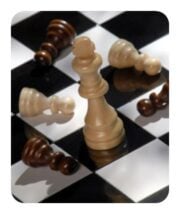 One of the first steps in capturing an opportunity is to conduct a win themes development and strategy session. Win themes are a conclusive set of reasons why the customer should select you over the competitors. Win strategy is determining what it takes to win, and what a potential winner would have to do to make it an obvious choice from the customer’s standpoint.
One of the first steps in capturing an opportunity is to conduct a win themes development and strategy session. Win themes are a conclusive set of reasons why the customer should select you over the competitors. Win strategy is determining what it takes to win, and what a potential winner would have to do to make it an obvious choice from the customer’s standpoint.
A brainstorming meeting on developing win themes helps you organize and focus your efforts. You need to define every aspect of what the customer ultimately desires, whether you have it or not. Then, you get to come up with the assessment of where you are, figure out the gap between the customer’s ultimate desires, and the action items to get there.
Everyone knows that you need to conduct a session like this for every pursuit, the question is: When? The answer is, of course, as early as possible.
Here is a reality check, though. In the time of a business development budget crunch, capture dollars are harder to come by. Even if you do engage in the capture effort, the expenses are hard to predict. Often RFP release dates tend to slip further and further to the right, and companies may end up (or simply fear to end up) spending more than they had planned to.
Many companies report dragging their feet on key capture activities because of schedule uncertainties. All of the planning and preparation gets put off because now it seems like the company has more time. A win themes and strategy session is one of those activities that gets delayed as well.
Ironically, win themes and strategy brainstorming session that lasts 4-7 hours is not the largest capture expense. It is arguably the most important capture activity, second only to meetings with the customer. Not having a win theme brainstorming session is one of the main reasons for capture failure.
Win themes are not the only product of such brainstorming. The other hugely important products are strategies and action items. These action items are the key when you cannot come up with an element of a win theme. As you may know, a win theme has three elements: feature, benefit, and proof. Benefits are driven by customer needs, but inevitably, you may be missing a feature for that desired benefit or proof that you can deliver that feature.
For example, if you have a win theme with a customer-desired benefit like “zero disruption to agency’s operations during the transition,” then you would figure that you need a feature such as “existing relationships with all the agency’s stakeholders,” and proof that you have such relationships. If you do really have them in place, then you need to find a teaming partner or reach into the personnel and annals of your own organization to see if you have them but don’t know about them. These are clear action items that, at a higher level, constitute win strategies.
Completion of these action items takes time. It’s not the win themes brainstorming that’s needs the time, it is the time between assigning the action items and updating your win themes to reflect what you have done that’s vital to your capture. In the example above, identifying, negotiating, and partnering with someone who has stakeholder relationships takes time to complete. Needless to say, you need to do so early so that this partner is not already taken.
The most frustrating thing in capture is to know about the opportunity well in advance, have all the time in the world, and be unprepared when it comes time to write the proposal. That’s what we call “snatching the defeat out of the jaws of victory.”
The earlier you run the win_themes development and strategy session, the better. If something slips to the right, so be it. It means more time to complete the action items.
Contact OST to set up a strategy session for developing win themes or participate in our one-day workshop on win themes development in January.
Best regards,
Olessia Smotrova-Taylor
President/CEO
OST Global Solutions, Inc.
…Because There is No Second Place in Proposals! TM
https://www.ostglobalsolutions.com
Contact us to learn more.
